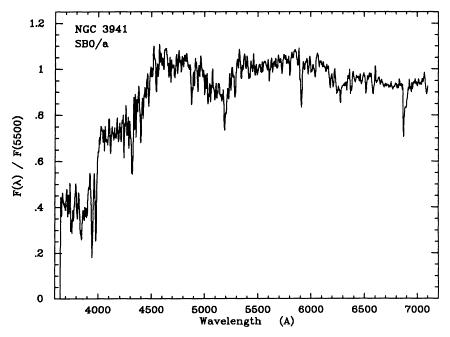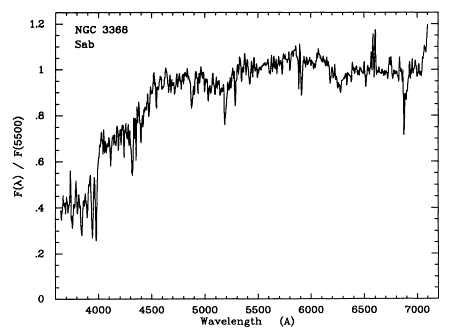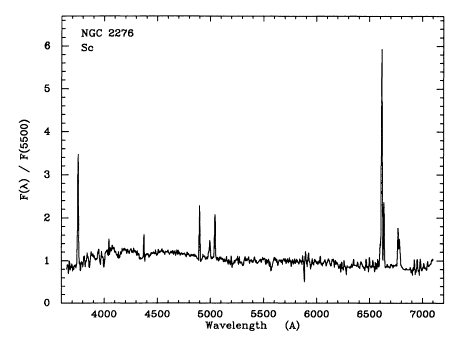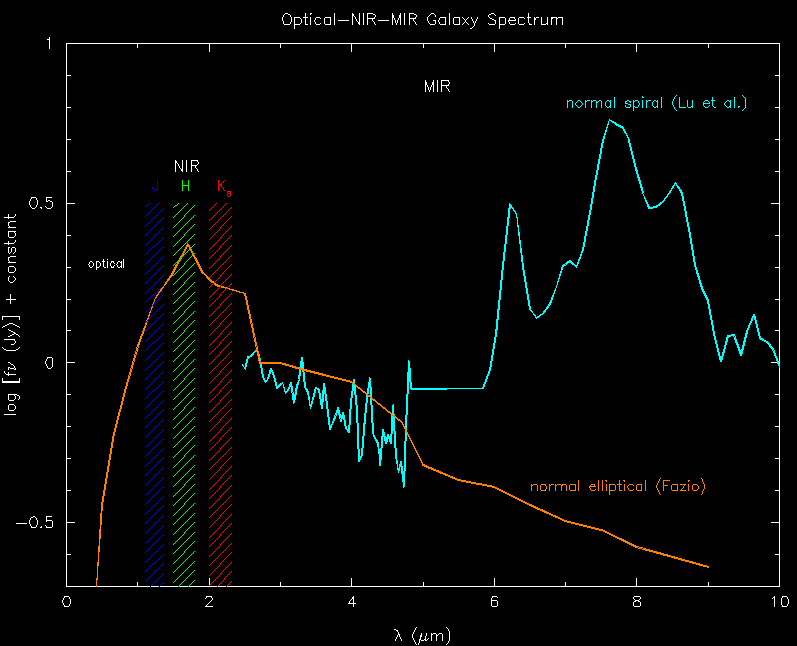
The masters of stellar population synthesis code (building a galaxy from individual stars) are Bruzual & Charlot. The Kennicutt atlas of optical galaxy spectra of various types can be found here. A popular set of UV galaxy templates are those of Coleman, Wu & Weedman. Here is a short introduction to the stellar populations found within typical galaxy spectra.
Galaxy spectra are typically characterized by a strong continuum component, caused by the combination of a range of blackbody emitters spanning a range in temperature. This produces a fairly flat overall spectrum. A primary feature is the strong break at 4000A (Angstroms), caused by the blanket absorption of high energy radiation from metals in stellar atmospheres and by a deficiency of hot, blue stars. A smoothly varying function can easily be fit to spectra, with a clear drop off in intensity at 4000A. Some stellar type spectra show the 4000A break clearly, while others do not, due to the presence of absence of metal lines and a strong blue/UV component. Based on the correlation between the strength of the feature with stellar type, in which type of galaxy would you expect a strong 4000A break - ellipticals, spirals, or irregulars?
There are absorption features superimposed on the continuum, due to the absorption of atoms (metals) and molecules in stellar atmospheres, and to cold, interstellar gas clouds which siphon off radiation at key frequencies. This implies the presence of old stellar populations, which are typical found in elliptical galaxies and in the bulges of spiral galaxies. Key features include the Calcium H and K lines (found at 3934A and 3969A), the G-band (4304A), and Magnesium (5175A) and Sodium (5894A) lines.
| Elliptical Galaxy Spectra |
 |
| Elliptical galaxy spectra are characterized by strong absorption lines, due to metals in the stellar atmospheres of the low luminosity stellar population. We see few to no emission lines ([OII]3727A and/or [NII]6583A are occasionally present), as there are essentially no young stars and no gas. |
| [Steward Observatory, R. Kennicutt] |
One will also see emission features, due to gas being heated and then re-radiating energy at specific wavelengths. Young stars form within gas clouds, which they then ionize. The emission from the Orion nebula, for example, is fueled by four bright O stars, which emit most of the ionizing photons (E > 13.6 eV) that energize the surrounding HII region.
 |
 |
| The center of the Orion Nebula is a churning, turbulent star factory set within a maelstrom of flowing, luminescent gas. Though this 2.5 light-year view is a small portion of the entire nebula, it includes a star cluster and almost all of the light from the bright glowing clouds of gas that make up the nebula. [NASA/HST] | |
Emission features thus point to very hot gas and OB type stars, from the disks of spiral galaxies and from irregular galaxies. Key features include the [OII] doublet (3737A), [OIII] (4959A and 5007A), and the Balmer series (6563A, 4861A, 4340A, 4103A, ...).
| Spiral Galaxy Spectra | ||
 |
 |
 |
 |
 | |
| Spiral galaxy spectra are characterized by strong emission lines, due to hot young stars which heat the surrounding gas, and by absorption features due to the older, underlying stellar population. | ||
| [Steward Observatory, R. Kennicutt] | ||
| Irregular Galaxy Spectra |
 |
| Irregular galaxy spectra are characterized by strong emission lines, due to hot young stars and surrounding HII regions. |
| [Steward Observatory, R. Kennicutt] |
Most galaxy spectra are redshifted (spectral features have shifted to longer wavelengths than the rest wavelength values), though some few are blueshifted. This is interpreted similarly to a Doppler shift, and implies that the galaxies are moving away from us (redshifted) or towards us (blueshifted). What is the spatial location of most blueshifted galaxies?
 |
Finally, we take a quick look at other bandpasses.
 |
| [NASA/2MASS] |